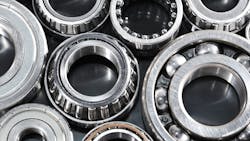Rolling bearings are essential components in automated machinery with rotating elements. They come in many shapes and sizes, but are essentially designed to carry a load while minimizing friction. In general, the design consists of two rings separated by rolling elements (balls or rollers). The rings can rotate can rotate relative to each other with very little friction.
A bearing, like other machine components, eventually fail due to wear-and-tear. But repairing defects can be prohibitive for two reasons: Firstly, the rings are inaccessible, and secondly, machine downtime is costly.
The ability to accurately predict the remaining useful life of the bearings under defect progression could reduce unnecessary maintenance procedures and prematurely discarded parts without risking breakdown, reported scientists from the Institute of Scientific and Industrial Research and NTN Next Generation Research Alliance Laboratories at Osaka University.
As defects develop inside a bearing, its vibration amplitude begins to fluctuate, noted the scientists. They created a spectrogram showing the intensity of different frequencies as a function of time. These two-dimensional graphs were used to train a convolutional neural network, which is a machine learning method for image recognition and vision tasks.
"Predicting the remaining useful life curve of rolling bearings under defect progression is usually difficult, owing to irregular fluctuation of vibration features," noted first author, Masashi Kitai.
The scientists used Bayesian hierarchical modeling to infer the parameters, including remaining lifetime. This approach allowed the scientists to integrate the results into a single set of predictions, along with associated uncertainties. During testing, the method improved the error of predicted remaining useful life by about 32%.
"More efficient maintenance of industrial machinery based on our technology may lead to reduced environmental burden and economic loss," said senior author Ken-ichi Fukui.
The scientists hope that future algorithms may be generalized to work with a wide range of mechanical parts and lead to new industrial monitoring methods for maintenance scheduling, efficiency and safety.
The article, "A framework for predicting remaining useful life curve of rolling bearings under defect progression based on neural network and Bayesian method" was published in IEEE Access at DOI.
About the Author

Rehana Begg
Editor-in-Chief, Machine Design
As Machine Design’s content lead, Rehana Begg is tasked with elevating the voice of the design and multi-disciplinary engineer in the face of digital transformation and engineering innovation. Begg has more than 24 years of editorial experience and has spent the past decade in the trenches of industrial manufacturing, focusing on new technologies, manufacturing innovation and business. Her B2B career has taken her from corporate boardrooms to plant floors and underground mining stopes, covering everything from automation & IIoT, robotics, mechanical design and additive manufacturing to plant operations, maintenance, reliability and continuous improvement. Begg holds an MBA, a Master of Journalism degree, and a BA (Hons.) in Political Science. She is committed to lifelong learning and feeds her passion for innovation in publishing, transparent science and clear communication by attending relevant conferences and seminars/workshops.
Follow Rehana Begg via the following social media handles:
X: @rehanabegg
LinkedIn: @rehanabegg and @MachineDesign


